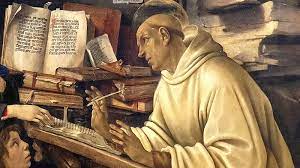The benefit for the country was that villages did not have to send their men and boys away and miss their labor on the farms or risk them not returning from war.
Those who made a living as mercenaries did not do so because they just answered an advertisement. Their evolution was organic and initially unwelcome, because they were not faithful to a lord or land and often took what they wanted from the locals. The Third lateran Council of 1179 condemned mercenary bands. King John's use of mercenaries led to their banishment in Magna Carta. They continued to exist on the continent, however, and the problem grew in the 1300s.
Shortly after the start of the Hundred Years War, bands of soldiers left in Brittany started harassing the countryside. With immediate battle over and no financial support from the crown, they began living off the land, which started as hunting and using up natural resources, but also turned to ransacking villages for supplies. Villages began paying soldiers "protection" money to leave them alone. The captain of a company could become quite wealthy, and maintain "control" over a large area. The most famous was John Hawkwood, whose career as a mercenary made him a celebrity in Italy. (The city-states of Italy preferred to hire soldiers from outside their territory, so that no powerful military force had any familial ties in the city-state that would challenge the political structure.)
These companies came to be known as routiers (German Rotten "gangs"; French routes "road"), and were foot soldiers such as archers, spearmen, and crossbowmen rather than mounted knights. They were often referred to as "Englishmen" in France because they were part of England's forces in the Hundred Years War, but the first groups of routiers were actually Gascons from the southwest part of France that had been in English hands for generations. (To be fair, they could also include English, Spaniards, and Germans.)
Even when a company of routiers was being paid to fight, however, their loyalty was to a paycheck, not the lord, and so their willingness to lay down their lives in battle was questionable. Nor did they have any loyalty to a particular country: the captain would move them to wherever they could be paid to fight or be paid to not pillage. Roving bands of routiers generally disappear from the landscape by 1400.
Those Gascons, however, and the Duchy of Gascony had a long history that is worth looking at next.




























